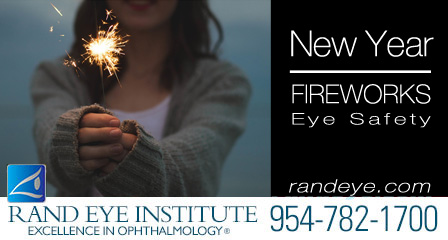How Safe are YOUR Kid’s Eyes This Summer?
Just as it’s warming up for summer, your kids are warming up their sports skills.
So with that in mind, we’ve got our EYE on sports eye safety for your children.
As we pointed out in our last article, more than 90% of all eye injuries can be prevented through the use of suitable protective eyewear. BUT, to help you be on the lookout for possible eye injuries this season, here are the most common eye injuries that kids incur:
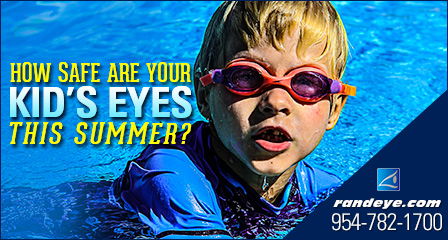
1. Water and pool activities rank #1 for eye injuries. More than 1/3rd of all pool and water activities that affect the eyes happen to kids under the age of 15.
2. Basketball accounts for 1/4th of all eye injuries that will happen to kids 14 and under. Hard to imagine that such a large object like a basketball could cause an eye injury. Of course it’s possible, but injuries in basketball are mostly caused by the fingers and hands of opponents, stressing once again, the need for players to wear proper eye protection.
3. Air, gas, spring and BB-guns, though today reclassified as firearms and removed from toy departments, still pose one of the biggest threats percentage-wise to your kid’s eyes. More than half of all eye injuries suffered from “toy guns” happen to kids 14 and under. Always stress to your kids that projectile-firing instruments should only be used under the supervision of a qualified adult and at a monitored and regulated facility, and of course, eye protection is mandatory.
4 – 7. Baseball, football, soccer and martial arts take up the next four categories of the highest-ranking eye injuries for kids 14 and under, with nearly 3,500 kids in that age group affected.
The takeaway here is that with summer approaching, your kids will spend a lot more time outdoors interacting in sports and that’s good. Just be aware of the need to acquire the appropriate eye protection for them, including instruction for use, so that they have an edge in preventing eye injuries while maximizing fun!
Source: AAO and Prevent Blindness
Buying Your Eyes Time and Protection in Sports
Most people believe that the best money spent is money that saves you from having to spend MORE money. So making a small purchase of just $20 to $40 to guard against eye injury or blindness could be the best EYE-vestment you’ll ever make.
With spring here and crisper weather in the air, the parks are filling up with kids and adults in their evening softball and soccer leagues. But before you slip on that baseball glove or new pair of cleats, don’t run the bases without running to the store first for proper eye protection.
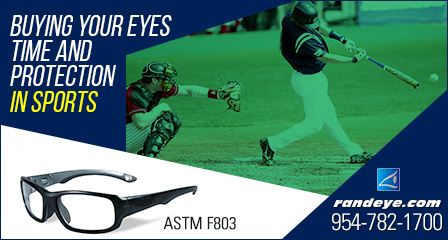
Here are some guidelines to help you choose proper eye guards:
Any eye guard or sports eye protector should be labeled “ASTM F803 approved”. This is the code for eyewear that gives you the highest level of vision protection. Put this code in the notes section of your smart-phone so that you can refer to it when you shop and check the package to see if the eye protection you chose has been approved for sports use.
Don’t scrimp or save on eye guards that don’t have lenses. Only “lensed” protectors are recommended for sports use. Choose eye guards where lenses stay in place or pop out in an accident. Make sure they don’t pop in, which can damage your eyes.
Eye guards should be anti-fogging for clearest vision. Others may have side vents that let air circulate, keeping the lens surface clear.
Padded or cushioned eyewear may cost a bit more, but the more comfortable it is on YOU the more comfortable YOU’LL be, and less likely to toss them to the bench.
Until you get used to playing sports wearing eye protection, it may feel a bit strange or uncomfortable, but hang in there, you only have one set of eyes – SEE that you protect them the best way possible.
And lastly, always try on different brands and sizes of eyewear for comfort and protection. There’s nothing worse than tossing away your eye guards due to discomfort, only to suffer an eye injury without them.
As always, in the event of an eye injury, always see an ophthalmologist or your eye doctor right away, or visit the nearest emergency room at once.
April Showers Us With Tips for Sports Eye Safety Month
Ah, Spring. What a time to be a sports fan. But while you have your eye on your favorite team’s schedule, don’t drop the ball on Sports Eye Safety. Keep these eye safety tips handy:
While each sport has specific recommendations for equipment that helps prevent bodily injuries, they all, without exception, recommend sports eye guards for every player.
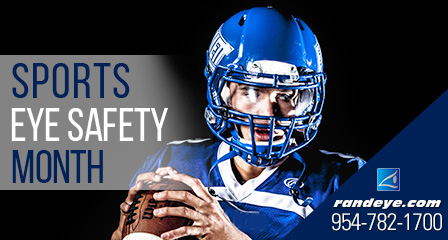
Prescription glasses, sunglasses and even occupational safety glasses do not provide the eye protection one needs* while playing recreational sports.
- Baseball: a batter’s helmet and a faceguard for catchers made of polycarbonate material is a must.
- Basketball: players run the risk of an eye socket fracture or scratches on the cornea without sports eye guards.
- Soccer: players could suffer an inflamed iris or swollen retina if they don’t put on proper eye protection.
- Hockey: players MUST wear polycarbonate masks and sports eye guards to help prevent traumatic injuries.
- Football: wearing a helmet with a polycarbonate shield attached to the faceguard is the best defense.
ALL sports participants run the risk of an opposing player’s finger in the eye without the proper eye protection. So remember, if you or your young ones are playing sports, make sure proper eye safety equipment is a part of the uniform.
*source: Prevent Blindness
**PLEASE NOTE FOR EMERGENCY EYE CARE – OUR OPHTHALMOLOGISTS ARE ON-CALL 24/7
Treating Eye Injuries Safely
We’ve had a lot of positive feedback on our last article about wearing proper protective eye equipment (PPE) when performing tasks that could be hazardous to your eyes. As we learned, there are only so many things in life that you can control, and wearing eye protection is one of them.
But what happens when you suffer an eye injury that is beyond your control?
The American Academy of Ophthalmology and Rand Eye Institute present some of the ways you can treat various eye injuries.
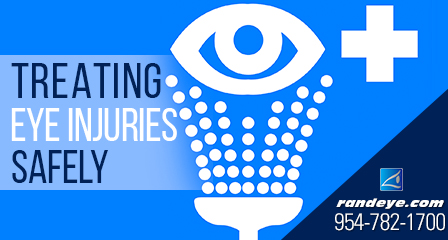
First step FOR ALL EYE INJURIES:
- Do not touch, rub or apply pressure to the affected eye.
- Do not try to remove the offending object from the eye.
- Do not apply ointment or medication to the eye.
- See an ophthalmologist or a medical doctor as soon as possible.
For a cut or puncture of the eye:
- Do not rinse with water.
- Do not remove the wedged/protruded object from the eye.
- Do not rub or apply pressure.
- Try loosely taping a paper cup or eye shield over the eye for protection; then seek help from a medical professional.
- Do not take aspirin, ibuprofen or other non-steroidal, anti-inflammatory drugs as these thin the blood and may increase bleeding.
For a liquid substance in the eye, or a chemical burn:
- Rinse your eye under a steady stream of warm, fresh water for 15 minutes. Just let it run into your eye and down your face.
- After rinsing, you can put a cool, moist compress or an ice pack on your eye, but don’t rub it.
- Call your eye doctor or emergency clinic to ask what is recommended for your injury. Tell the person what kind of substance got into your eye and what you’ve done about it so far.
A direct hit to the eye, from a ball or hard object:
Apply a small cold compress, gently, to reduce pain and swelling. Do not apply any pressure.
If a black eye, pain or visual disturbance occurs after a light blow, contact your eye professional or visit an emergency room right away.
Getting particles or foreign materials in the eye:
- Do not rub the eye.
- Carefully lift your upper eyelid. Blink several times to allow tears to flush the particles. If you have sterile eye drops, try using them. If the particles remain, keep the eye closed and seek medical attention right away.
As a precautionary measure, contact your ophthalmologist or eye doctor for additional assistance. Your doctor may need to see you right away, or suggest you visit an emergency clinic at once. It’s always safest to have someone drive you, even if you think you’re ok to drive. Always err on the side of caution because we only get ONE pair of eyes.
What is PPE? It’s Insurance for your Eyes
You’ve no doubt heard of a PPO and an HMO, but have you ever heard of a PPE?
PPE stands for “Personal Protective Equipment”, and it refers to clothing, footwear, goggles, gloves, helmets and other garments designed to protect us from injury or infection. But since March is Workplace Eye Wellness Month, let’s just concentrate on our eyes.
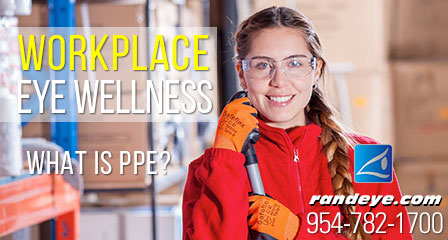
All joking aside, protecting your vision is paramount in maintaining quality of life, like seeing your grandkids or going for a leisurely Sunday drive.
Please don’t risk injury for vanity. Industrial Safety and Hygiene News reports that 70% of total eye injuries are a result of flying particles, flying or falling objects or sparks that strike the eye. Though companies can offer you eye protection and education, it’s up to you to actually put them to use.
Starting a new job? Helping a co-worker with a chemical or assisting in the construction of a project at work or home? It only takes one mishap for a life-changing event to happen that could cause you to lose your vision. Always make a note of where eye protection is located, familiarize yourself with the instructions, and most importantly, actually wear the eye protection. It’s 10-seconds of safety that could save your vision and your life.
Next time, we’ll talk about recognizing and treating eye injuries.
New Year Fireworks – Eye Safety Tips
Whether you’re saying “Au Revoir” to 2016 or getting ready to welcome in 2017, we want to make sure you remember “safety first” when planning to be around fireworks this New Year’s Eve.
Practice fireworks eye-safety during your celebration: Keeping it safe and fun for the entire family.
- First and foremost, do not use illegal explosives, professional fireworks, or any fireworks that you did not obtain from a licensed retailer in your city. Unlicensed fireworks can be dangerous to you and your eyes, which may lead to eye trauma and blindness.
- Make sure the area where you will be lighting fireworks has a safe perimeter between you and the spectators, that it’s free of overhead obstructions and away from dry grass or flammable materials, including automobiles. Look out for flaming embers flying through the air that could land in your eyes.
- When igniting approved fireworks, always wear safety gloves and protective eyewear and never allow children to assist in engaging fireworks. You can easily obtain small, non-igniting battery-operated lit toys that the kids will enjoy.
- If you’re attending a professional fireworks display, like the ones hosted by your local city or town, remember, THEY’RE THE EXPERTS. Don’t bring your own fireworks, which in fact is usually against park rules.
The National Council on Fireworks has more tips here to help you safely ring in the New Year.
Have a safe celebration and a happy & healthy New Year from the Rand Eye family.
Safe Toys List
Santa’s busy in his workshop, so while he and the Elves are getting ready for Christmas deliveries, we “present” a list that YOU might want to check twice before heading out to complete your side of the shopping, because December is:
Safe Toys and Celebration Month
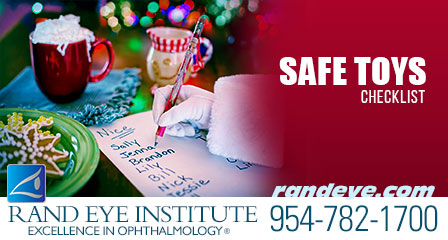
The public safety non-profit, which has been keeping an eye out for our kids since 1973, is W.A.T.C.H., which stands for “World Against Toys Causing Harm”. They’ve done the legwork for parents all over the country with their list of the “10 Most Dangerous Toys of 2016”, designed to help moms, dads and Santa pick out the perfect and safest gifts this holiday. Please take a moment to look it over. You might even want to share this link with friends and family, to ensure that their gift giving choices for your kids are in line with toy safety. Check out the list here.
Luckily the “bad” list is small and we can browse through a very long “good” list on Good Housekeeping’s website “Good” toys for 2016. Their experts vetted 500-plus new toys for safety, quality and skill-building and compiled their list of Toy Award Winners, they then asked the toughest critics of all- kids – to name the “bestest” of them all. Click here to start making your list.
Have a SAFE and Happy Holiday Season.
Safe Toys and Celebration Month
‘Tis the season when gift giving is (almost) as much fun as receiving, and because it’s Safe Toys and Celebration Month, let’s do our best to make sure that the gifts our children SEE on Christmas and Hanukkah are safe and fun for them all year long.
According to the U.S. Consumer Product Safety Commission, nearly 252,000 toy-related injuries were treated in emergency rooms in 2014, and almost half of those affected the head or face. The commission reports that 1 in 10 of those children’s eye injuries treated in the ER trace back to toys. Some propelling toys like paintball guns and darts have the potential to cause serious eye injuries and even permanent vision loss.
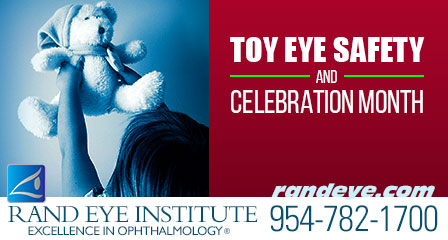
When choosing a toy for a child consider these Top Toy Safety Tips:
- Avoid toys with sharp, protruding or projectile parts that could end up in their eyes.
- Make sure children are supervised by an adult when playing with toys or games that could cause an injury, especially to the eyes.
- Always provide children with the appropriate protective eyewear with polycarbonate lenses if recommended by the manufacturer of the toy or sporting equipment. Click here to learn which protective eyewear is recommended for your child’s sport.
- Keep toys made for older children away from younger children, who may accidentally hurt themselves, or suffer an injury to their eyes or face.
If your child does experience an eye injury during playtime, seek immediate medical attention from an ophthalmologist or medical eye doctor.
Have a safe and happy Holiday Season and a wonderful New Year.
Carving out a Niche This Halloween and Making it Safe for Kids
Nothing says, “Welcome to Fall” like the orange glow of a pumpkin patch. Time to pick out a healthy, robust pumpkin for your Fall Halloween decorations, and carve out some fun by adding your own decorative design to his mesmerizing mug.
Have fun with your pumpkin this Halloween, but please observe these Halloween Safety Tips first before carving ol’ Jack, courtesy of Rand Eye Institute and The American Academy of Pediatrics.
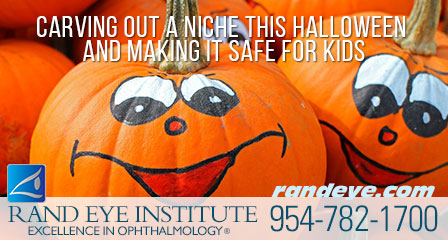
While carving the pumpkin is a fun family activity that has so many layers, (design, baking pumpkin seeds, carving and construction), remember, small children should never carve pumpkins, let the adults do that. Children can draw his face with markers, or using a paper template, have them suggest where to poke the holes through the paper, so an adult can do the carving.
Consider using a flashlight or glow stick, instead of a real candle to light the inside of the pumpkin. Try using a small battery-operated LED candle, they’re inexpensive, reusable, come in a variety of colors and they flicker just like real candles. A candle left unattended is not only dangerous, but the heat from the candle melts the pumpkin prematurely, no one likes a floppy pumpkin.
So in the 35-year tradition of Rand Eye Vision safety-first tips, use your Rand EYE-Q this Halloween to keep your little ghosts, ghouls and goblins safe!
Halloween Safety Tips 2016
Happy Halloween: Dressing you up with helpful suggestions and important safety tips relating to your child’s vision, from; Rand Eye Institute and The American Academy of Pediatrics.
The Halloween we remember as kids is long gone. Today, in this all-consuming world of multi-tasking, mobile electronics and Pokémon chasing, our kids need to be especially vigilant and aware of their surroundings during Halloween. It’s also up to us as parents to make sure that the trick-or-treaters get only treats. So with that in mind, here are some helpful Halloween tips for kids of all ages:
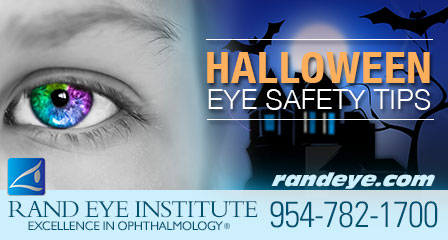
I’m Happy to See You
Masks can block or restrict your child’s vision, consider non-toxic makeup instead. Coming up with an original idea for makeup is a great way to engage your child about the creation of their own costume while helping them to be safer outside.
Lenses and Safety Senses
When it comes to vision, never allow the wearing of decorative contact lenses; colored contacts should always be prescribed by your eye doctor. Obtaining decorative contact lenses without a prescription is both dangerous and illegal and may cause eye infections and/or serious eye problems, leading to permanent vision loss.
Dress Up for Safety
Plan costumes that are bright and reflective. Always add reflective tape or striping to costumes, a flashing necklace or light, and don’t assume all costumes have to be dark. Creating light and reflection alerts an approaching vehicle to slow down for trick-or-treaters. When shopping for costumes and accessories, always look for a label clearly indicating that they are flame resistant. Also, make sure shoes fit well and that costumes are short enough to prevent tripping or getting caught or entangled.
No Cane Do
Be careful of too many accessories like a cane, a sword or a stick. If your child has one, make sure it’s not sharp or too long. Your child could be hurt if they stumble or trip, and they should be using their free hand to hold a working flashlight that has fresh batteries inside.
Be The King of The Mall
And lastly, Trick or Treating doesn’t have to be in the neighborhood. Check with your local shopping mall, many offer safe and well-lit trick-or-treat-streets inside the mall, or consider hosting a Halloween party for the kids at your house.

